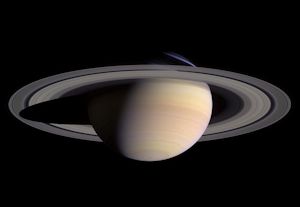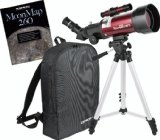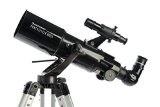Setting expectations
If you have read my article on why telescopes end up in the garage collecting dust then you know that high expectations vs the reality of telescope performance can quickly put an end to the use of a telescope.
So this is the number one thing that you should do with a child. Communicate clearly what should be expected with a telescope. But first I can tell you how to frame the whole situation. Using a telescope is like a treasure hunt. The real reward is actually in hunting through the nigt sky and finding recognizable objects like Saturn, Venus, Jupiter, the constellations and the Andromeda Galaxy. Yup, all those things are findable with any telescope.
So that's the big thing. The real joy in telescope use is in the hunt. Make that the goal.
Because.....
Television and the Web have taught us that objects in the night sky look like this:

But the reality is that when the child looks through the telescope this is what he or she is going to see:

Which is actually quite wonderful. For the entire history of humanity we never saw anything like this -Let alone average every day people. It is an astonishing accomplishment - to spend a few dollars and be able to do this.
But the facts are the facts. A child can be disappointed because this isn't what we have been accustomed to seeing.
And pair up this mismatching of expectations with the fact that you have to do this at night when a child is going to easily get sleepy and the telescope might end up in the garage collecting dust after one lackluster hour of viewing.
Ok, so what can you do to set the expectations in a way that the whole experience will be a wonderful and enriching experience for a child?
I have some advice for you.
First - Spend time learning about astronomy and telescopes before you get a telescope or before you take one out at night. Actually using a telescope is only part of the joy that comes from astronomy. Learning about the night sky and how it all works is a very big part of it. And then treasure hunting to find these things is where the value of the telescope comes in. The telescope should be be paired up with the learning that comes ahead of time.
Let me give you a great example of what I mean. Here is what you might see when you find jupiter. Pretty nice! But wait. What are those four white dots?
Well, those are the Jovian satellites. The four biggest moons that revolve around jupiter. Notice how they are on a plane with the equator of jupiter.

Now here is the big thing. You could do a sketch of this or have the child do a drawing of this -taking special note of the position of those four satellites.
And then return to the telescope a few hours later or the next night and what has happened?
Well, those satellites have moved.

And one or more of them may be missing. This is because it is either right in front of Jupiter or right behind it.

You can start the adventure here:

The night sky is full of wonders like this. And doing some reading and exploring ahead of time will bring these wonders to life. And it will change the expectations of the child to something different.
This book is a great place to start and it keep to my philosophy of enjoying and learning about the night sky. I own this book and I have also bought it as a gift for someone else .
A Child's Introduction to the Night Sky
So now let's take a look at some telescopes. Let's run this up a scale to make it easy.
The first place you can start is without a telescope. Just identifying constellations can be very rewarding. And you can find several of the planets with just the naked eye. These include Venus, Mars, Jupiter and Saturn. Although whether or not each is viewable can depend on the time of year and time of night. They all rise and set just like the moon.

After constellation hunting and naked eye viewing. Which is all done with the help of a book or star charts you could consider an upgrade to binoculars. It is a great, and inexpensive way to start. But consider the weight of the binoculars. Bigger ones, while giving better views of objects in the sky, can quickly fatigue a child's arms. Bushnell Falcon Binoculars
Try my book. I specifically wrote it to help you enjoy your small telescope.

See It with a Small Telescope: 101 Cosmic Wonders Including Planets, Moons, Comets, Galaxies, Nebulae, Star Clusters and More - Available in paperback and kindle on Amazon right here
Ok, Now let's look at telescopes.
I have a recommendation on what not to buy.

I suggest you don't buy one of the very common 60mm telescopes. They made tens of thousands of these things and every company has a couple of different ones. They look like a "telescope". It is a very identifiable thing. At one point I had five of them because they often turn up in second hand stores for ten dollars. I get them for the lenses :)
The picture here is one of mine. You probably recognize this size and shape of telescope.
Let me explain why you might want to avoid this type of telescope. (two reasons)

First off, the mount for these telescopes is often not very stable. It might appear stable when you look at and move it around. But.... magnify the telescope by 50 power to look at something in the sky, and the shake is also magnified 50 times.
That's a big thing!
Not all of these common 60mm telescopes are unstable like this. The Companies Celestron and Meade make some that are stable though.
The second reason. And this is a big reason.
Think about looking through a paper towel tube. When you look through that tube you only see a little bit right? You have a very limited view of things. And no peripheral vision at all. You just see the area of a small circle. That's it. And when you use a telescope like this on the night sky you only see a small portion of the sky.
And this can make it very difficult to find anything other than the moon. You will be hunting around, moving the telescope, trying to find anything at all. It can be frustrating.

This is your view with one of these commonly found 60mm telescopes.

But there is a way to correct this problem. That is by getting a different telescopes. Some telescopes have a much wider field of view like you see in this illustration here.
When you have a larger field of view it is so much easier to find things in the night sky.
How do you get this larger field of view? You get it by getting a smaller focal length telescope. Yup, a shorter telescope. But one with the same lens size on the front. Really as simple as that. And, because you have a shorter telescope it is also lighter, easier to use, and much more stable on its tripod. It is literally a win win situation all the way around.

Orion GoScope II 70mm Refractor
I like this telescope for a few different reasons. First off it is small and manageable in size. Yet, you still get a 70mm main lens which is a bit of a bump up without the bump up in price. And you get a bunch of accessories to go with it including a prism that makes it easy to view from comfortable positions or easy to use during the day on things other than the sky.

Celestron 21087 PowerSeeker 80AZS Telescope
And for better performance, but more cost this telescope is by one of the premiere telescope making companies. And the main lens is even bigger (80mm) so this telescope is an even better performer. And being a short tube scope we still get that wonderfully larger field of view.
So that's it. That was our fun romp through the universe of introducing a child to astronomy and telescopes. I hope this was helpful for you. But.... one thing I can say is that I bet this article and all of this about telescopes and celestial objects probably piqued your interest too! Have fun with the new telescope whichever one you end up getting!
Here are more telescopes on Amazon.

Orion 10028 StarBlast 70mm Altazimuth Travel Refractor Telescope

Do you like making projects and exploring a variety of hobbies?
Sign up for my free newsletter. I give you regular updates on hobbies and projects you can make. it is totally free and I don't share your email with anybody.
|
![]()




















